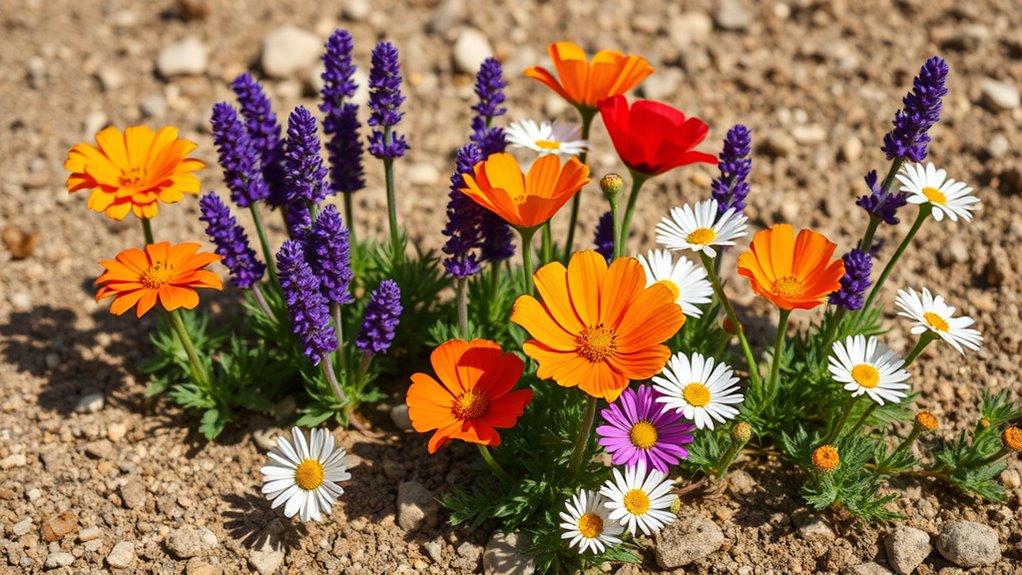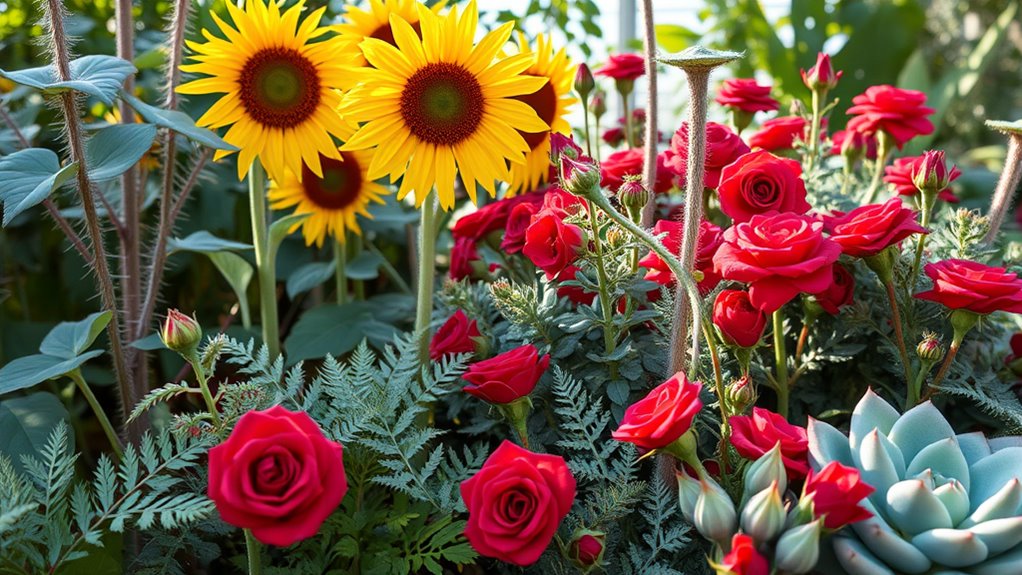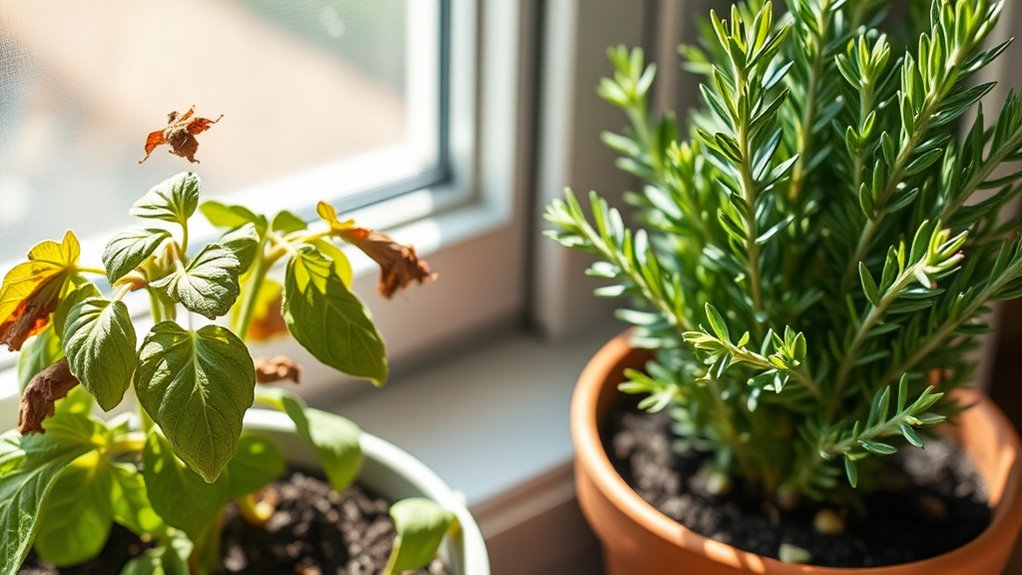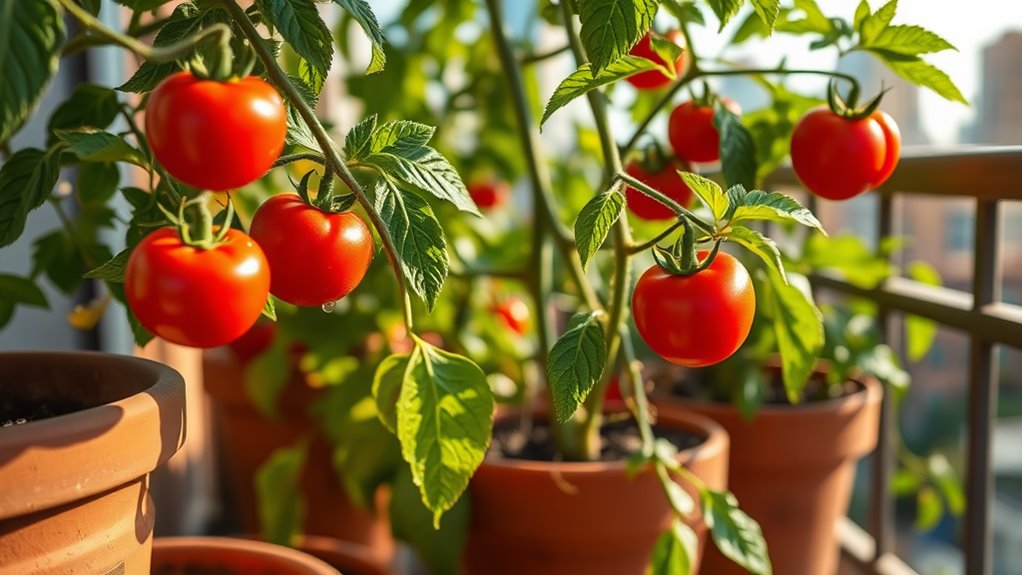10 Flowers That Thrive in Poor Soil – Grow Anywhere!
You can easily grow lavender, marigold, cosmos, zinnia, poppy, yarrow, coneflower, black-eyed Susan, portulaca, and sunflower in nutrient-poor soils. These resilient plants boast deep roots and drought tolerance, allowing efficient water uptake and minimal fertilizer needs. They’re low-maintenance, pest-resistant, and boost garden ecosystems through vibrant blooms and pollinator attraction. Explore their specific adaptations to transform your space into a thriving haven.
Key Takeaways
- Lavender, zinnia, poppy, portulaca, marigold, cosmos, sunflower, yarrow, coneflower, and black-eyed susan thrive in nutrient-poor soils.
- These flowers have deep roots and drought tolerance, making them ideal for dry, rocky areas with minimal watering.
- They require low maintenance, including occasional pruning or deadheading to extend blooming.
- Many attract pollinators and improve soil health, enhancing garden biodiversity.
- Plant in full sun with well-drained soil for optimal growth and resilience in challenging conditions.
Lavender
Lavender is one resilient flower that thrives in poor soil, demanding little more than good drainage and sunlight.
As one of the tough flowers, you appreciate its ability to withstand drought and nutrient scarcity through deep roots that efficiently absorb water.
Scientifically, its aromatic oils deter pests, enhancing garden health.
You plant it in well-drained spots for optimal growth, where it blooms vibrantly under full sun.
Prune regularly to promote bushiness, and harvest blooms for teas or oils, turning poor soil into a productive space with minimal effort.
Additionally, Lavender shares characteristics with low-maintenance herbs that flourish even with minimal care.
Lavender is featured among the top 10 resilient flowers that are ideal for gardeners facing challenging soil conditions.
Marigold
You can grow marigolds in nutrient-poor soil, as they tolerate it exceptionally well without needing rich amendments.
This resilience makes them a practical choice for your garden beds in challenging conditions.
Additionally, you’ll appreciate how marigolds require little water, allowing them to flourish with minimal irrigation.
As low maintenance plants, marigolds are ideal for novice gardeners seeking effortless greenery.
To make gardening these resilient flowers even easier, incorporate budget-friendly tools that provide excellent value for maintaining your plots.
Tolerates Poor Soil
Marigolds thrive in nutrient-poor soils, adapting quickly to low fertility and drought with their robust root systems. You can plant them in sandy or clay-heavy areas where nutrients are scarce, boosting your garden’s resilience without extra amendments.
To maximize their soil tolerance:
-
Embrace diverse pH levels****: Marigolds flourish in acidic to neutral soils, making them versatile for various sites.
-
Leverage root efficiency****: Their extensive roots scavenge nutrients effectively, reducing the need for fertilizers.
-
Promote companion growth****: You plant marigolds alongside vegetables to improve overall soil health naturally.
This approach lets you enjoy vibrant blooms effortlessly.
Requires Little Water
In addition to thriving in poor soil, these resilient flowers require minimal water to maintain their vibrant blooms.
When you grow marigolds, you’ll find they flourish with just occasional watering, thanks to their deep roots that tap into hidden moisture reserves.
Scientifically, their waxy leaves reduce evaporation, conserving water efficiently during photosynthesis.
You can check soil dryness with a simple finger test; water only when the top inch feels dry to avoid root issues.
This drought tolerance lets you enjoy bold, orange blooms in dry gardens, making marigolds a practical, low-maintenance choice for sustainable landscaping.
Cosmos
You can grow Cosmos in poor soil conditions since they’re highly tolerant of nutrient-deficient and dry environments.
It’s straightforward to plant them by selecting a sunny spot and sowing seeds directly, which minimizes transplant shock.
By incorporating soil preparation techniques, beginner gardeners can further enhance the growth of Cosmos even in challenging conditions. Additionally, applying essential techniques for soil preparation can help improve overall plant health and resilience.
Cosmos Soil Tolerance
Cosmos flowers thrive in poor soil, adapting quickly to nutrient-deficient conditions that challenge many other plants. You can rely on them for vibrant blooms in sandy, rocky, or compacted earth, where they minimize root stress and maximize resilience through efficient nutrient uptake.
-
Tolerate low fertility: Cosmos extract essential nutrients from minimal sources, reducing the need for amendments.
-
Handle poor drainage: They flourish in well-drained but nutrient-scarce soils, avoiding root rot in challenging conditions.
-
Adapt to pH variations: You thrive with Cosmos in acidic or alkaline soils, as their robust systems maintain growth stability.
Easy Growth Tips
Growing Cosmos is straightforward once you understand a few key techniques, allowing you to maximize their resilience in various conditions.
Begin by sowing seeds directly into poor, well-drained soil in spring, after the last frost; they germinate in 7-10 days under full sun.
Thin seedlings to 12-18 inches apart for optimal air circulation, reducing fungal disease risks.
Water sparingly—Cosmos are drought-tolerant, so overwatering invites root rot.
Deadhead faded blooms regularly to extend flowering periods.
Monitor for pests like aphids; apply neem oil promptly for control.
These methods ensure vigorous growth with minimal input, thriving even in challenging soils.
Zinnia
Zinnias thrive in nutrient-poor soils, thanks to their deep roots and drought tolerance.
These vibrant annuals, native to scrublands, let you add bold colors to your garden without rich amendments.
Scientifically, their efficient water use and nutrient uptake make them resilient and low-maintenance.
To maximize your Zinnia success:
- Choose heat-tolerant varieties**** for better performance in dry, poor soils.
- Plant in full sun**** to promote strong growth and prolific blooming.
- Practice deadheading to extend the flowering season and boost seed production.
To further support their growth in challenging conditions, consider applying mulch to enhance soil health and improve moisture retention, drawing from proven gardening techniques.
Additionally, implementing mulch application can keep your Zinnias consistently moist and thriving throughout the growing season.
You’ll enjoy reliable blooms that enhance biodiversity and beautify your space.
Poppy
Poppies handle nutrient-poor soils with ease, drawing on their hardy roots and ability to self-seed in tough conditions.
You’ll thrive with these flowers in your garden, as they adapt quickly to sandy or rocky spots.
Plant poppy seeds directly in fall or spring, requiring minimal fertilizer—just ensure well-drained soil to prevent rot.
Scientifically, Papaver species store nutrients efficiently in taproots, boosting drought tolerance.
You monitor for pests like aphids, but poppies’ resilience means they’re low-maintenance. For optimal results, integrate organic tips to naturally boost your garden’s vitality.
Experiment with varieties like California poppies for vibrant blooms that self-propagate annually, enhancing your landscape effortlessly.
For even better results, consider applying organic gardening hacks to promote thriving plants sustainably.
Sunflower
Sunflowers adapt effortlessly to nutrient-poor soils, leveraging their deep taproots to access hidden moisture and minerals.
You’ll thrive with these hardy plants in your garden, as they convert tough spots into vibrant displays, boosting biodiversity and even providing edible seeds.
To maximize sunflowers in poor soil:
- Select drought-resistant varieties**** like ‘Mammoth’ for better survival in arid conditions.
- Plant in well-drained areas**** to prevent root rot while encouraging deep growth.
- Apply minimal fertilizer****—just compost—to maintain their natural resilience without overfeeding.
This approach lets you enjoy tall blooms with little effort, enhancing your landscape scientifically. Incorporating backyard solutions can further improve soil quality using natural, readily available materials.
Embracing sustainable fertilizing practices, such as homemade compost, can help maintain soil health while supporting sunflower growth in challenging conditions.
Yarrow
Yarrow thrives in nutrient-poor soils, drawing on its deep, fibrous roots to access moisture and minerals that other plants often miss.
You’ll appreciate its resilience; it’s a hardy perennial that tolerates drought and poor conditions with ease.
Scientifically known as Achillea millefolium, yarrow features aromatic foliage and clusters of vibrant flowers in colors like white, yellow, and pink.
For optimal growth, sow seeds in full sun and well-drained soil, spacing plants 12-18 inches apart.
It attracts beneficial insects, enhancing your garden’s ecosystem without extra effort, and requires little maintenance to flourish year after year.
Coneflower
Coneflower, known scientifically as Echinacea, thrives in nutrient-poor soils thanks to its robust root system that scavenges water and minerals from deep underground.
You can grow this hardy perennial in your garden, where it produces striking, daisy-like flowers that boost biodiversity. It’s low-maintenance and resistant to pests, making it ideal for challenging sites.
To maximize your Coneflower‘s potential:
- Select drought-resistant varieties**** for extreme conditions.
- Space plants 18-24 inches apart to allow root expansion.
- Water sparingly after establishment, focusing on deep, infrequent sessions for strong growth.
Black-Eyed Susan
Black-Eyed Susan, or Rudbeckia, thrives in nutrient-poor soils with its extensive root network that draws up scarce water and minerals. You’ll appreciate its drought tolerance, as it flourishes in sunny spots with little maintenance, producing cheerful yellow blooms that attract pollinators and enhance your garden’s biodiversity. It’s easy to grow from seeds, requiring minimal fertilizer to avoid over-nourishment.
| Feature | Benefit |
|---|---|
| Root System | Efficiently absorbs scarce nutrients |
| Drought Resistance | Reduces watering frequency |
| Pollinator Appeal | Boosts local ecosystem health |
| Low Maintenance | Saves time and resources for you |
Portulaca
Portulaca, known as Moss Rose, flourishes in nutrient-scarce soils thanks to its succulent leaves that store water and minimize evaporation.
You’ll find it perfect for your dry garden, where it produces vibrant, colorful blooms that withstand heat and neglect. As a low-maintenance option, it adapts easily to sandy or rocky spots.
For successful growth, consider these key adaptations:
- Its CAM photosynthesis efficiently conserves water in harsh conditions.
- The plant’s thick leaves reduce transpiration, thriving with minimal rainfall.
- Drought tolerance allows it to outcompete weeds in poor soil.
Scientifically, this resilience means you can enjoy reliable flowering with little effort, enhancing your landscape sustainably.





